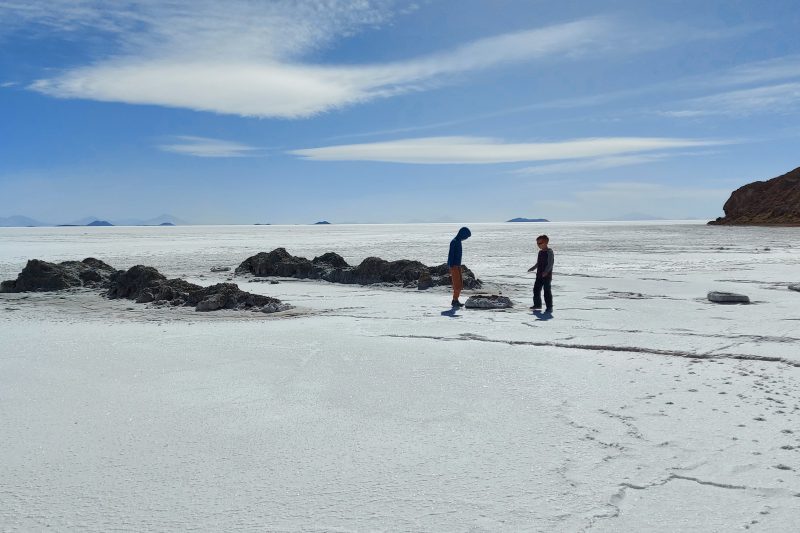White Sucre
Sucre really delivers on what the name suggests: beautiful white buildings in the city center against the colorful people make it a vibrant place to be. We have settled into a great apartment just outside of the center, but around the corner from the market that sprawls outside of its building for blocks on end. This is what we really enjoy about Bolivia; the hustle and bustle of people and all the colors and smells you pick up. The kindness of the people and especially towards Bo and Luc is really fun to watch, although the boys do get tired of all the hands over their heads.
We spend the whole day exploring the city, resulting in 17kms (!!) of hilly walking where we tick off many of the city’s highlights. From the market – where we order a fresh jugo at the jugo section – we walk into the main square and then upwards toward the beautiful viewpoint. A must see here is the …. Museum; a museum about the different indigenous groups of Bolivia and its cultural differences in music, weaving, celebrations and so on. We have lunch in one of the many cafes with a courtyard behind its colonial façade, and a quick hop into the cemetery before it closes; which really rivals the Recoleta of Buenos Aires in terms of flashy mausoleums! Very tired we cook dinner at home before calling it a day.
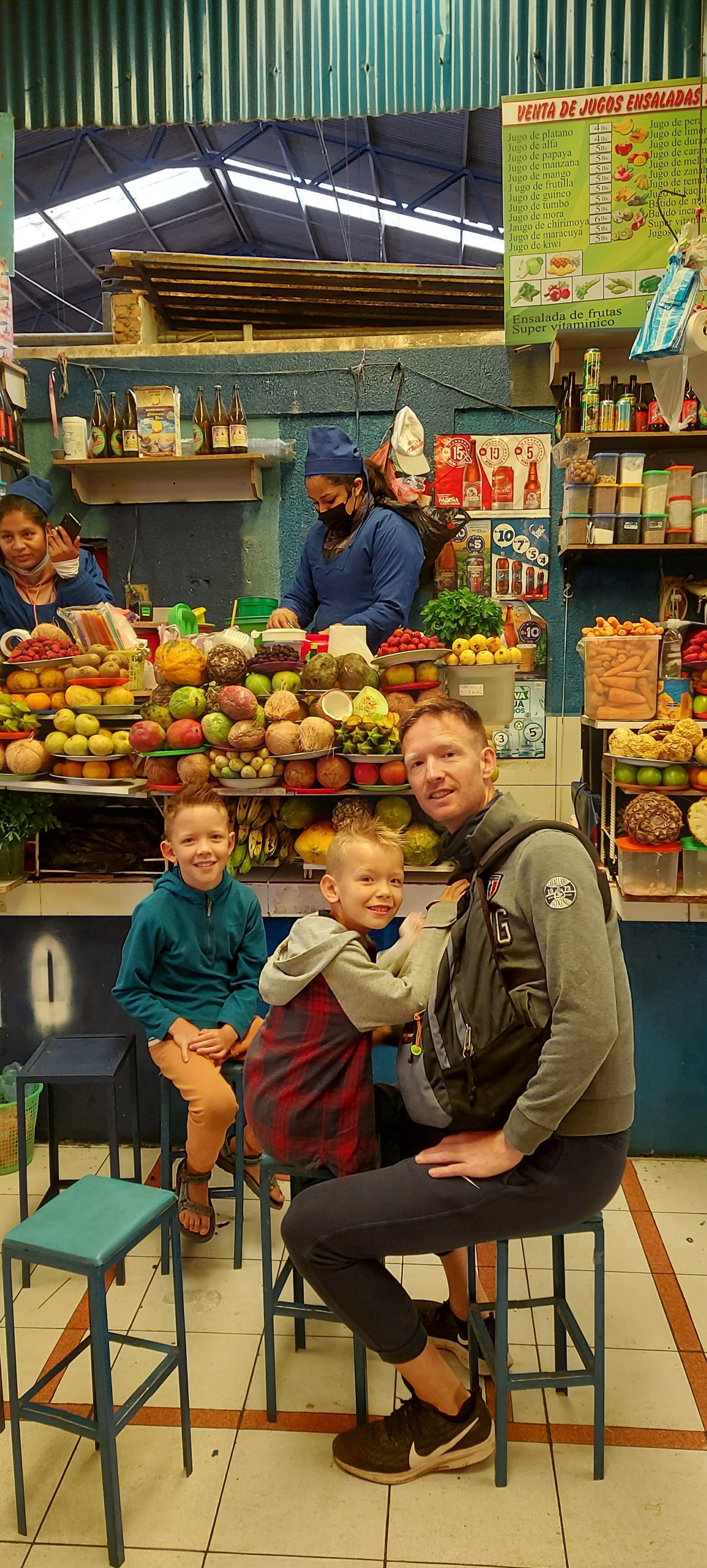
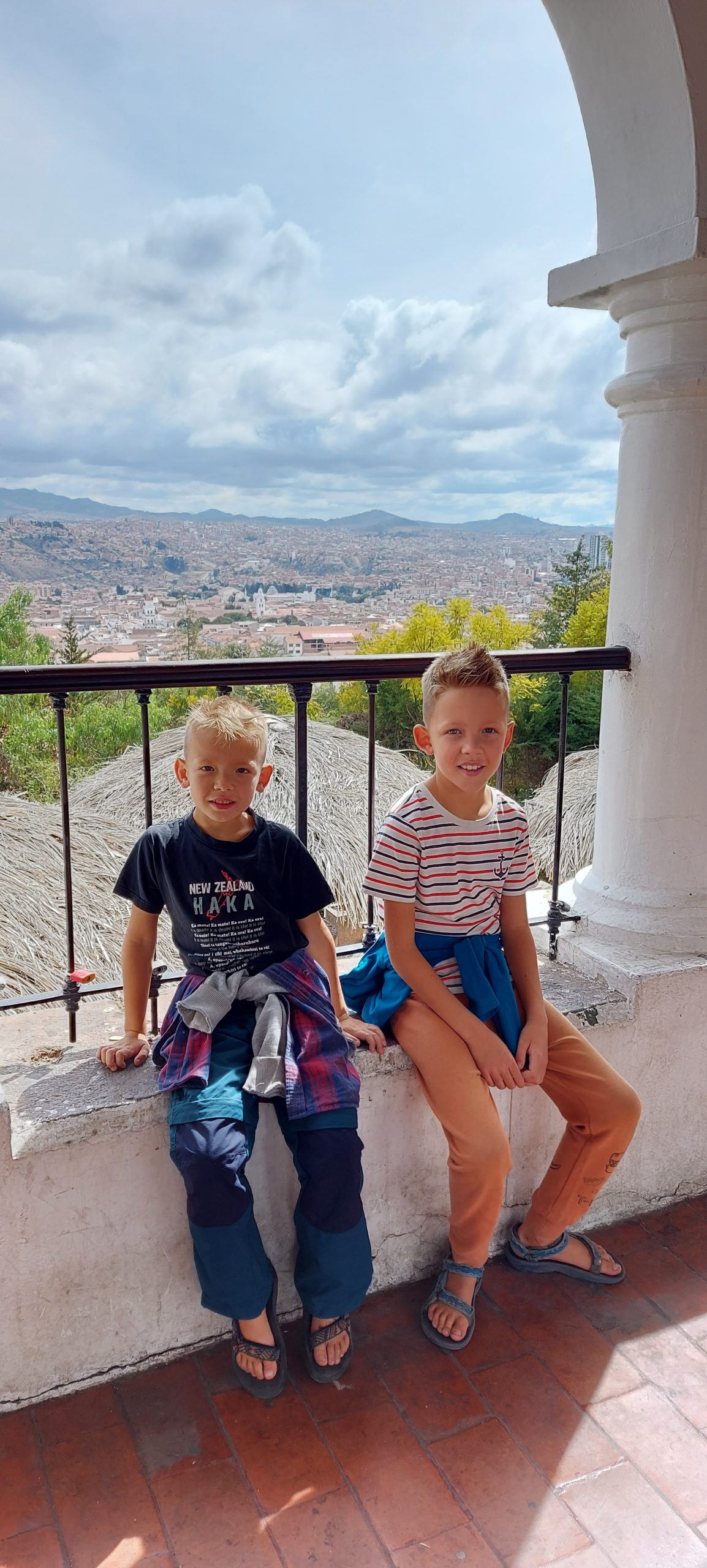
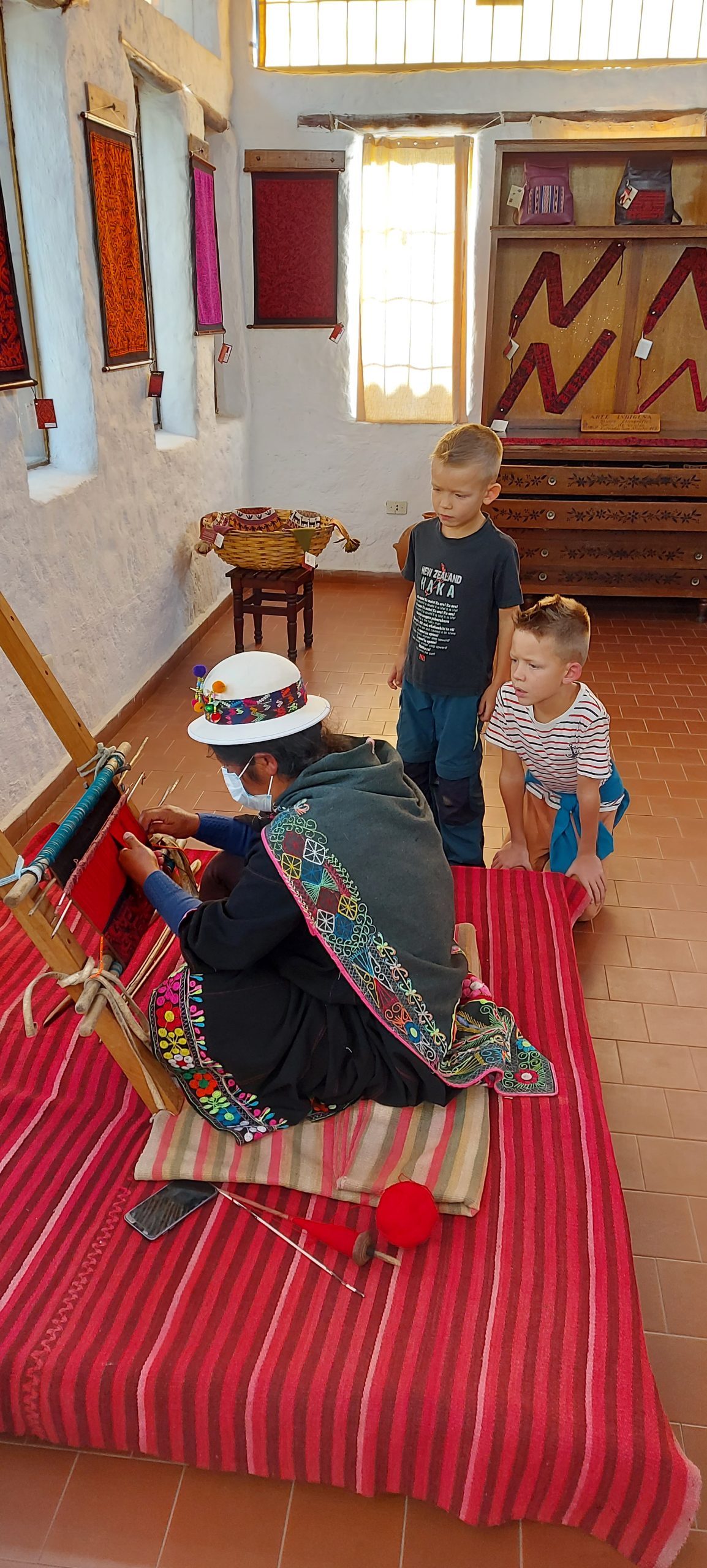
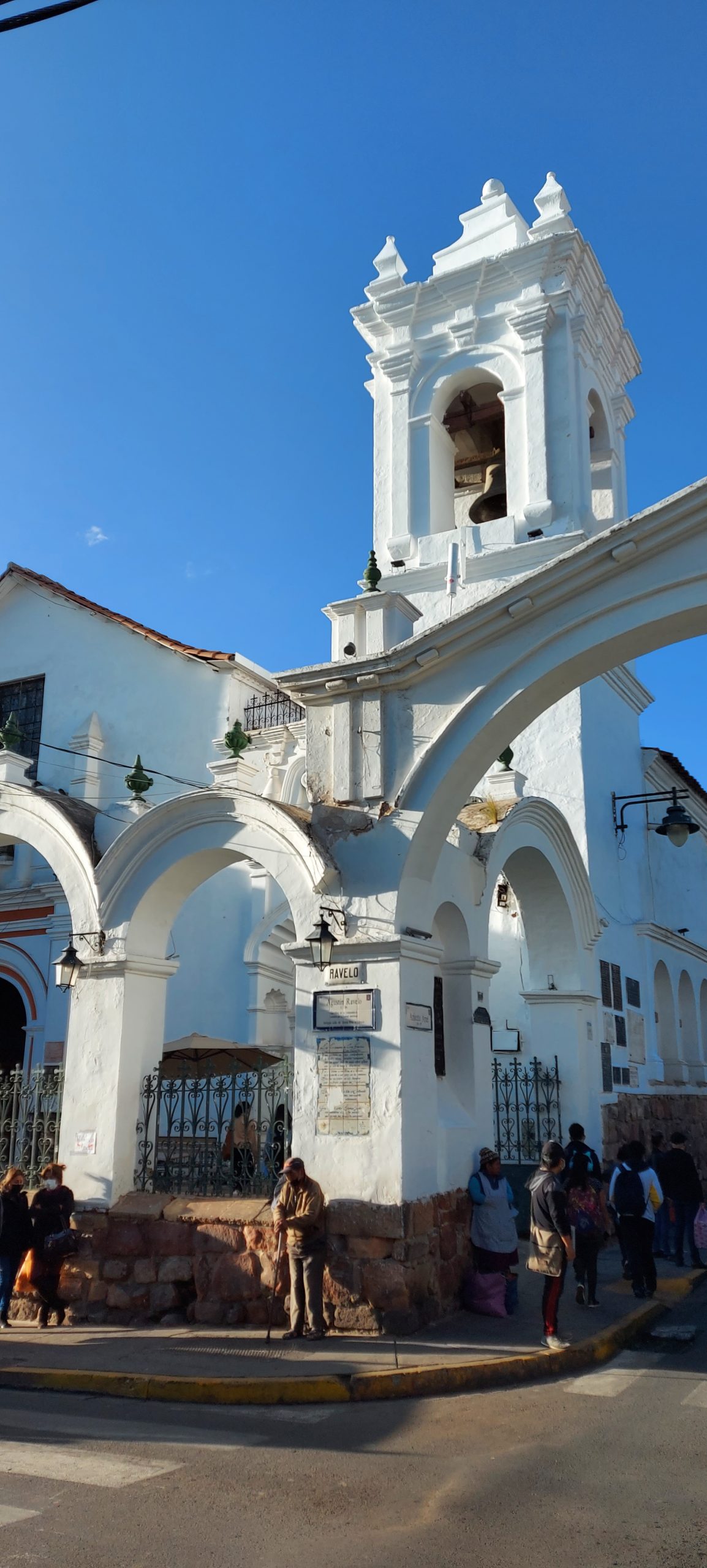
Potosi – Silvermine city
The next day we have a few hours drive ahead of us to make it to Potosi, know for its ‘Cerro Rico’ or Rich Mountain filled with silver (and thus mines). To get there, we need to get gas, and with no host to help us we give it a go ourselves. We park across the street and pull our jerrycan out of the roofbox, then walk towards the petrol station and ask them kindly if they can help with fuel at the local price. Some hesitation and friendly conversation later we manage to fill up the jerrycan twice at the national price, which is less than half of the foreigners rate!
Arriving in Potosi a few hours later, after crossing some stunning valleys filled with llamas, we find our hotel in the middle of the center in a dead-end alley. It is a monastery turned hotel, which means it has thick adobe walls and a courtyard, and of course very small rooms! Ours has a window with a fantastic view though and the location itself is unbeatable. As our boys are too young for a mine tour (minimum 10 years old) we do the next best thing and go to the ‘Casa de la Moneda’ which is the former mint of Bolivia. Here we learn about Potosi’s rich history (once a bigger city than Paris and London combined!) and its current challenges. After a delicious hamburger meal we call it a night and with a few hours spent in town the next day we say goodbye to Potosi

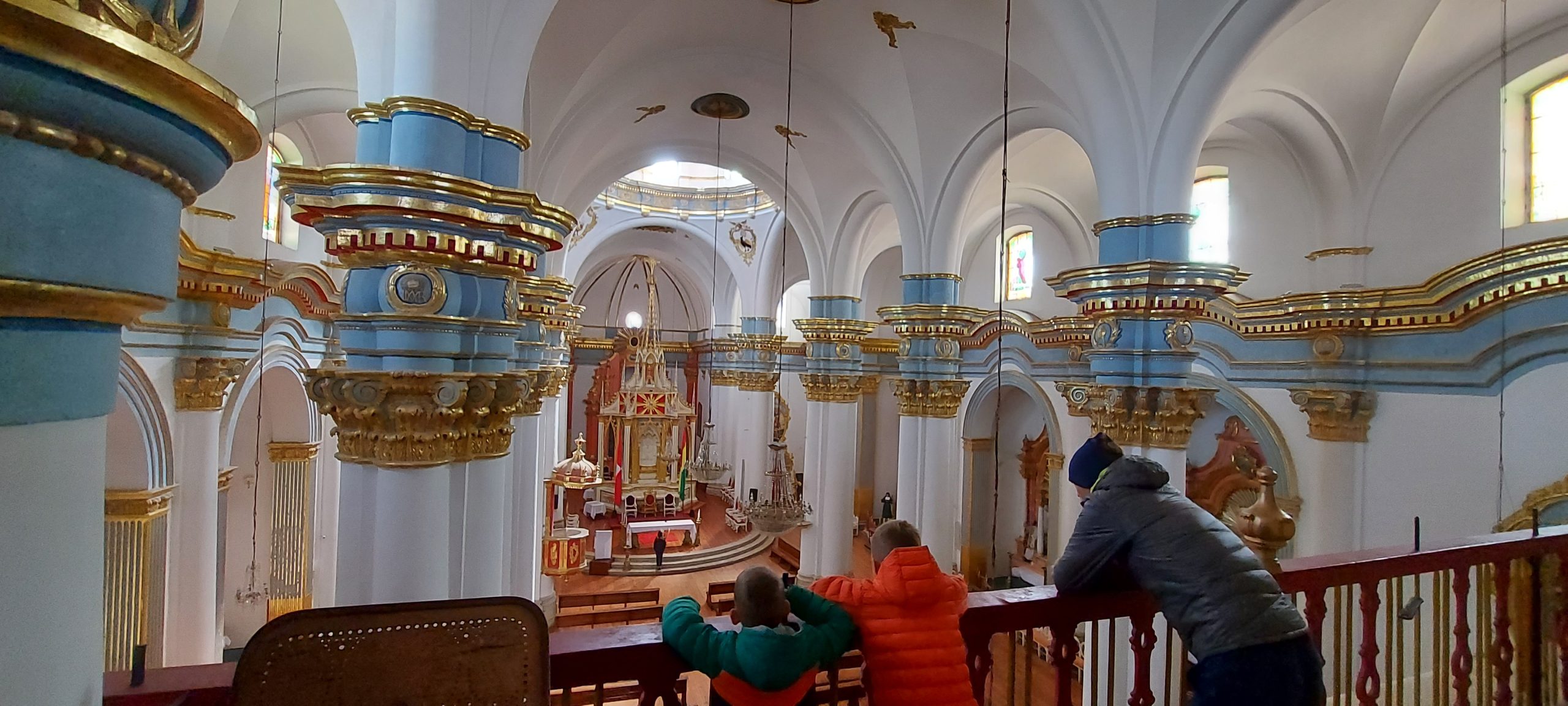
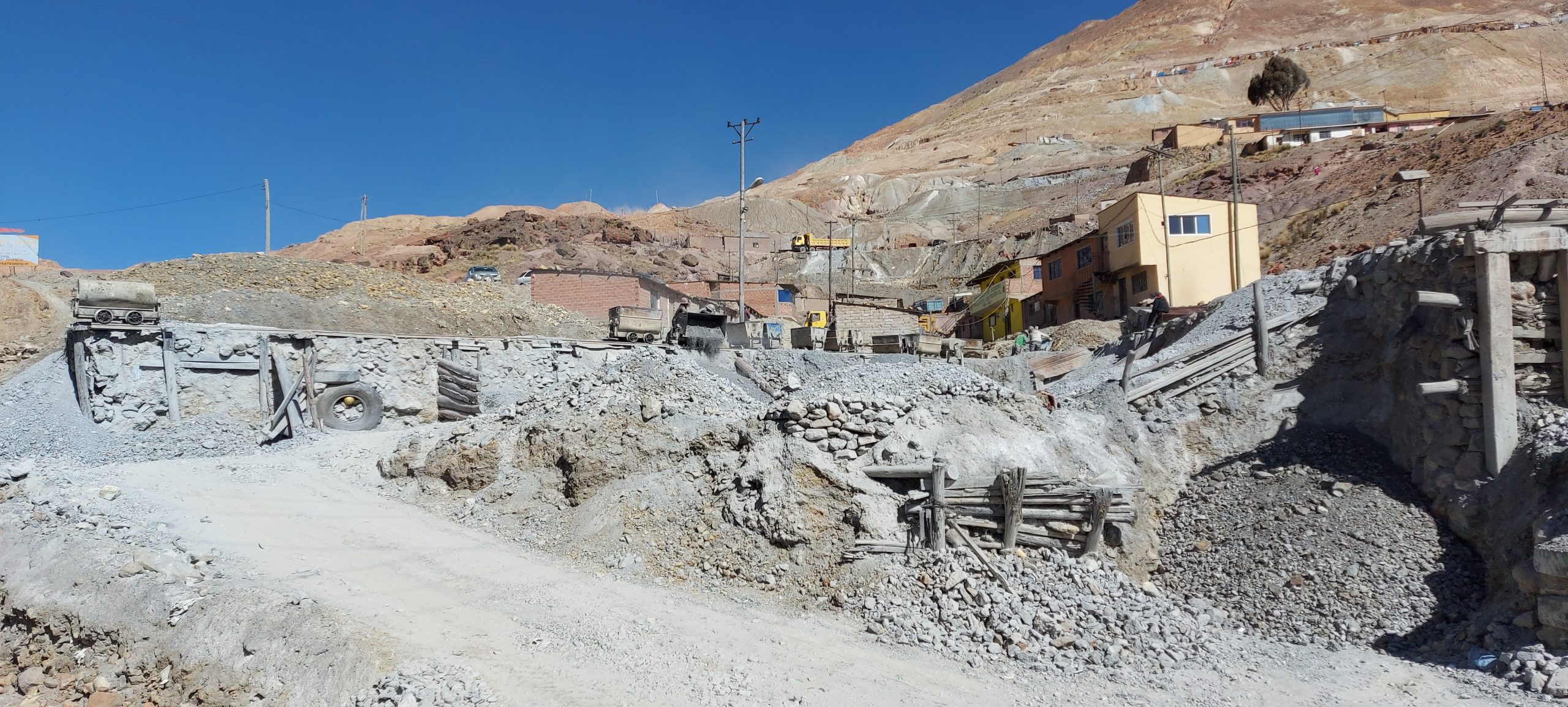
Uyuni and its Salt flats – Let the adventure begin!
Next on the list is Uyuni, and to get there we climb higher and higher – we have taken it slow these days, but that does not take away a bit of a headache and shortness of breath. Uyuni itself does not have that much to offer, but right on the edge of town is what is know as the ‘train cemetery’. A great climbing playground consisting of dozens of train engines and carts left in the desert to rot away. Needless to say the boys pull out their climbing gloves and spend a very long time because they have to climb EVERY train that is left there… and to be fair, us parents get a good climb in as well 😊.
The real prize here however are the salt flats of Uyuni; the biggest in the world and a quarter of our home country’s size with over 10.000km2. With salt being the name of the game, we decide to have an overnight stay in a salt hotel – you guessed it, it is built out of salt blocks! The enormous room and the luxury for the night should prepare us for a few nights of very basic accommodations and cold, so we decide to fully enjoy the experience with a dip in the jacuzzi and a hearty llama meal (not so tasty by the way). The breakfast is stellar, and prepares us well for what is to come: The Salar of Uyuni, and the Ruta de Lagunas bringing us to the border with Chile in the south of Bolivia.
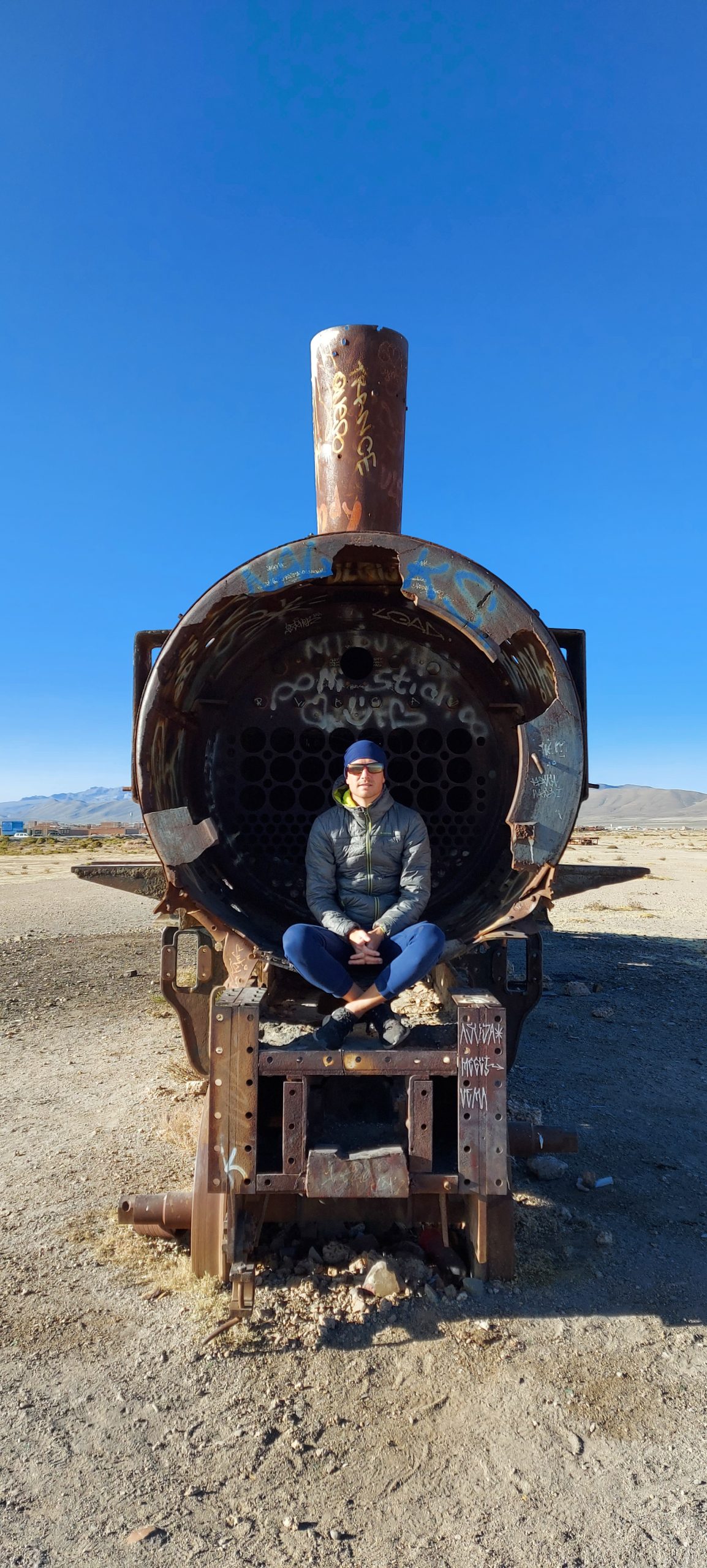


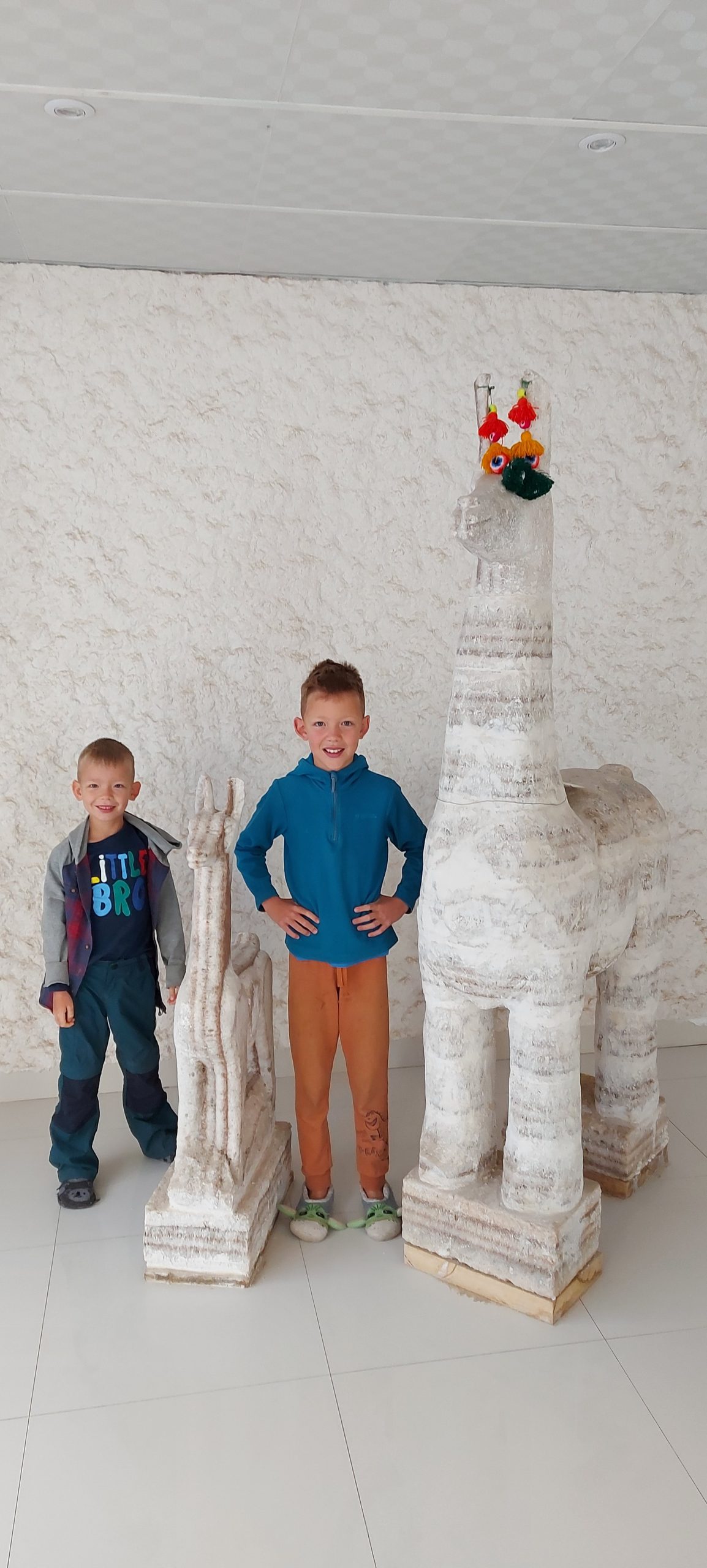
The salt flats are a true marvel, and with the borders having been closed for 2 years (and only recently opened with Chile) tourism has really come to a halt in this area of the country. When we last visited Bolivia there would be queues of land rovers driving on the roads of the salt flats (much of it destroyed by them already depending on the time of year you come here), now we are pretty much alone, adding to the somewhat eerie feel of the flats. The sheer size of them also turns out pretty daunting driving them ourselves this time – The little islands seem really close by, but often are still 40-50km and almost an hour drive away! You really get tricked by this when trying to navigate, but it also adds to the fun as we drive around and let our car do the work, visiting several of the islands on the flats.
Another fun part is of course making the epic pictures you can find when you Google Uyuni salt flats. Believe us that for every good picture there are at least 10 bad ones! Not as easy to do as it seems, and many of the great ideas we had driving in utterly failed, but we have a few that came out really well. After all the exploring it was time to exit the flats on the southside, but with little traffic so far from tourists, the ‘roads’ are not that clear as most cars exit again on the eastern side. We drive down and keep a close eye on our GPS, but the ground quickly turns wetter and before we know it we are driving through 20cm of salt water with 80km/h!!
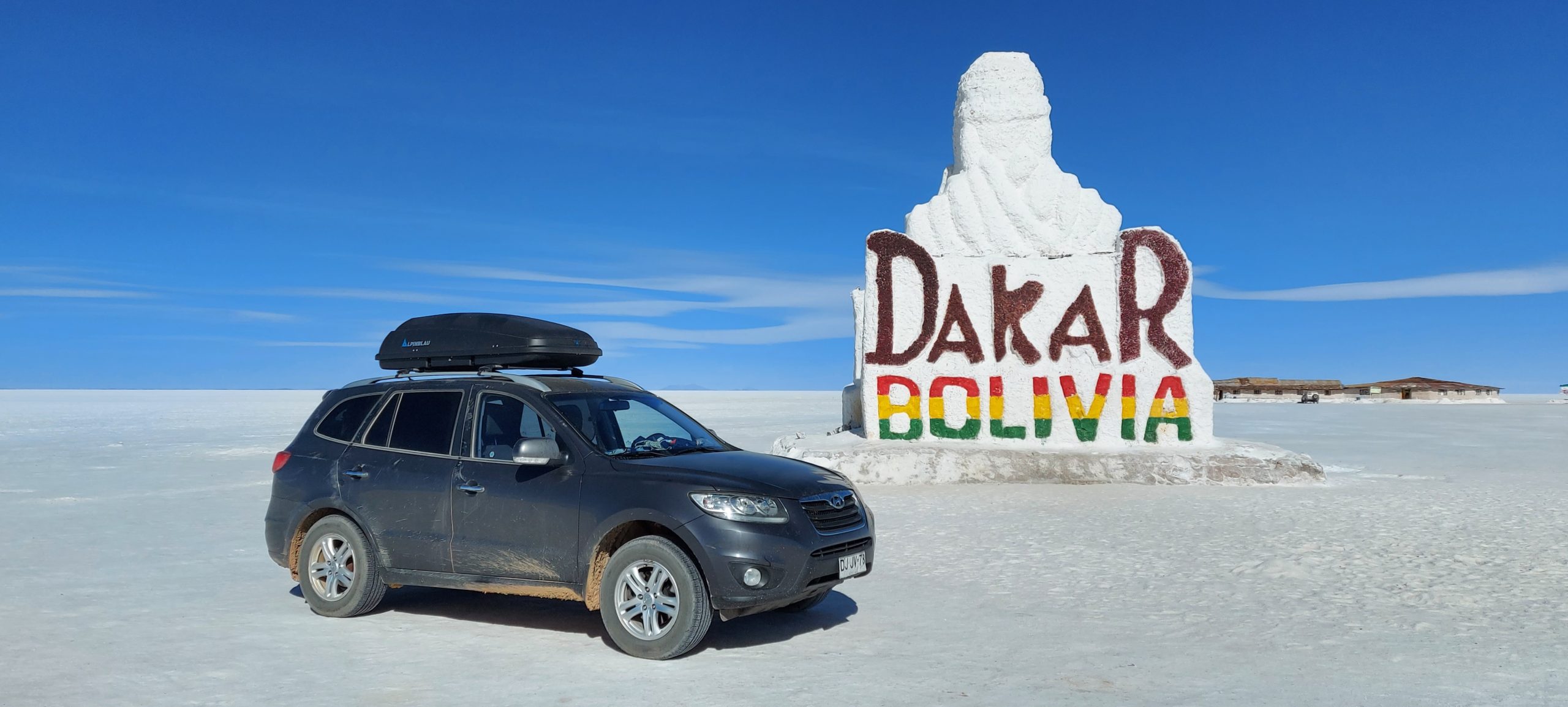
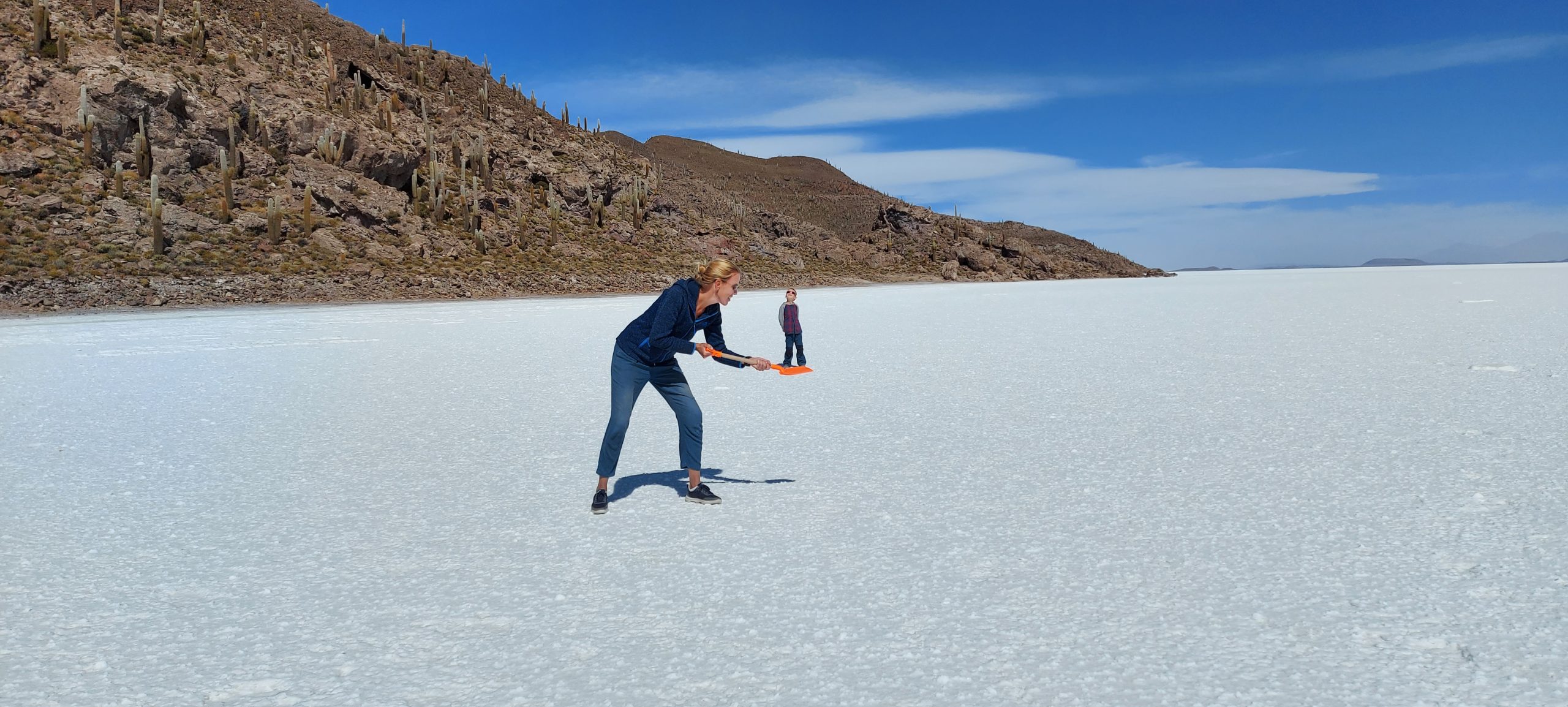
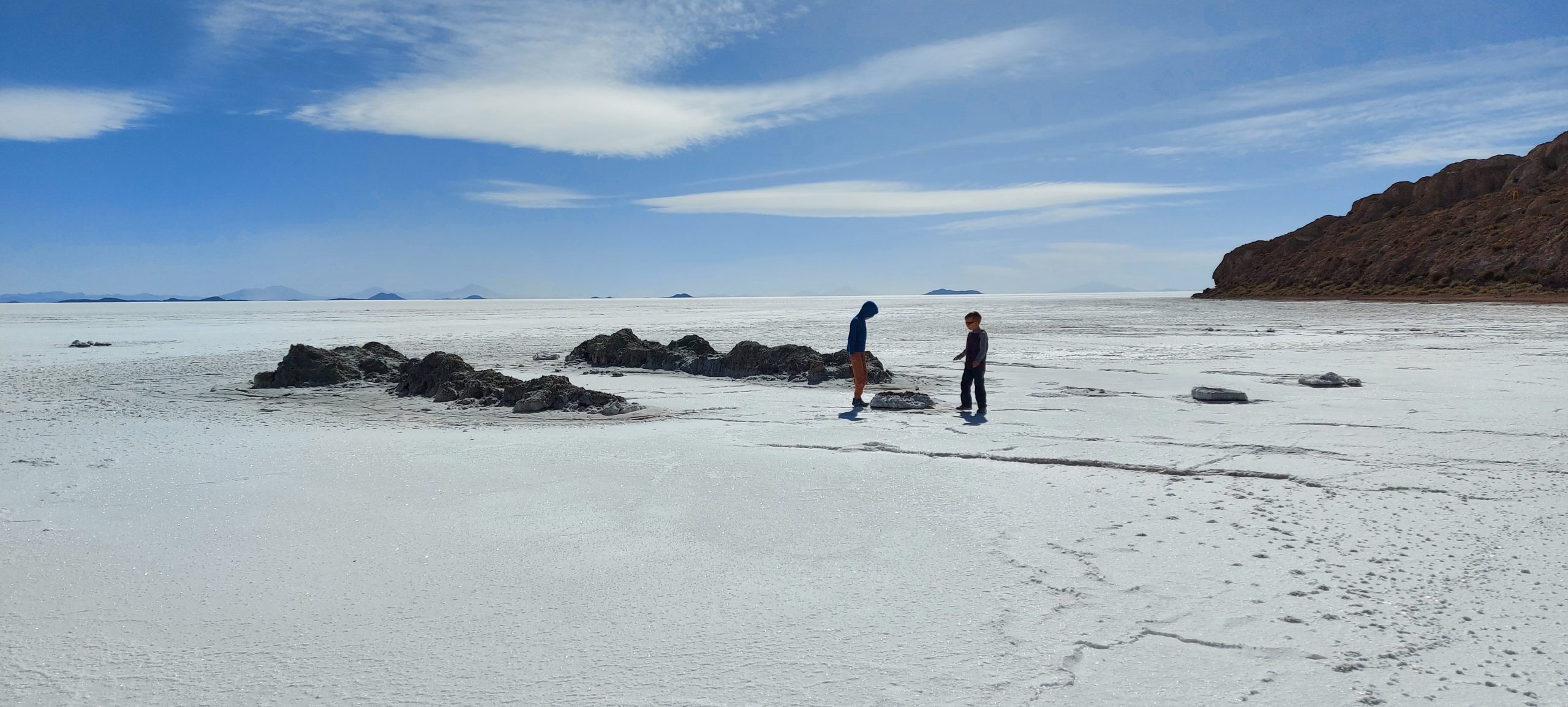
The biggest risk here is that at the edges of the salar, the salt crust gets thinner and what is underneath is a layer of mud that apparently can easily swallow a truck (hindsight knowledge, just to be clear)!! Struggling to find our 4×4 button and keep an eye on where we are going as salt water gushes over our car – window wipers turn out to be quite useless in such a situation – we manage to turn the car around and get out of this wet hole… just barely! Shaken by the experience and uncertain if we can find the proper road out, we decide to go back the way we came and make a 260km detour instead of the 12 km we still had to go.
Coming off the salar we immediately have our car cleaned thoroughly by the specialized lavadores (they wash the car from all angles and spray the bottom and wheels with oil) to avoid any salt damage to the car, and then speed our way through Uyuni to the other side of the salar where our hostal for the night is. The lady was not expecting us anymore as we roll in at 19:00 in the evening, but our driving skills got us around as fast as we could and only driving in the dark for about half an hour. Being the only ones in the hostal we cook a quick pasta and try to get warm under the terrace heater in the restaurant. All in all, it is a great story to tell in hindsight, but not an experience we need to have again any time soon!
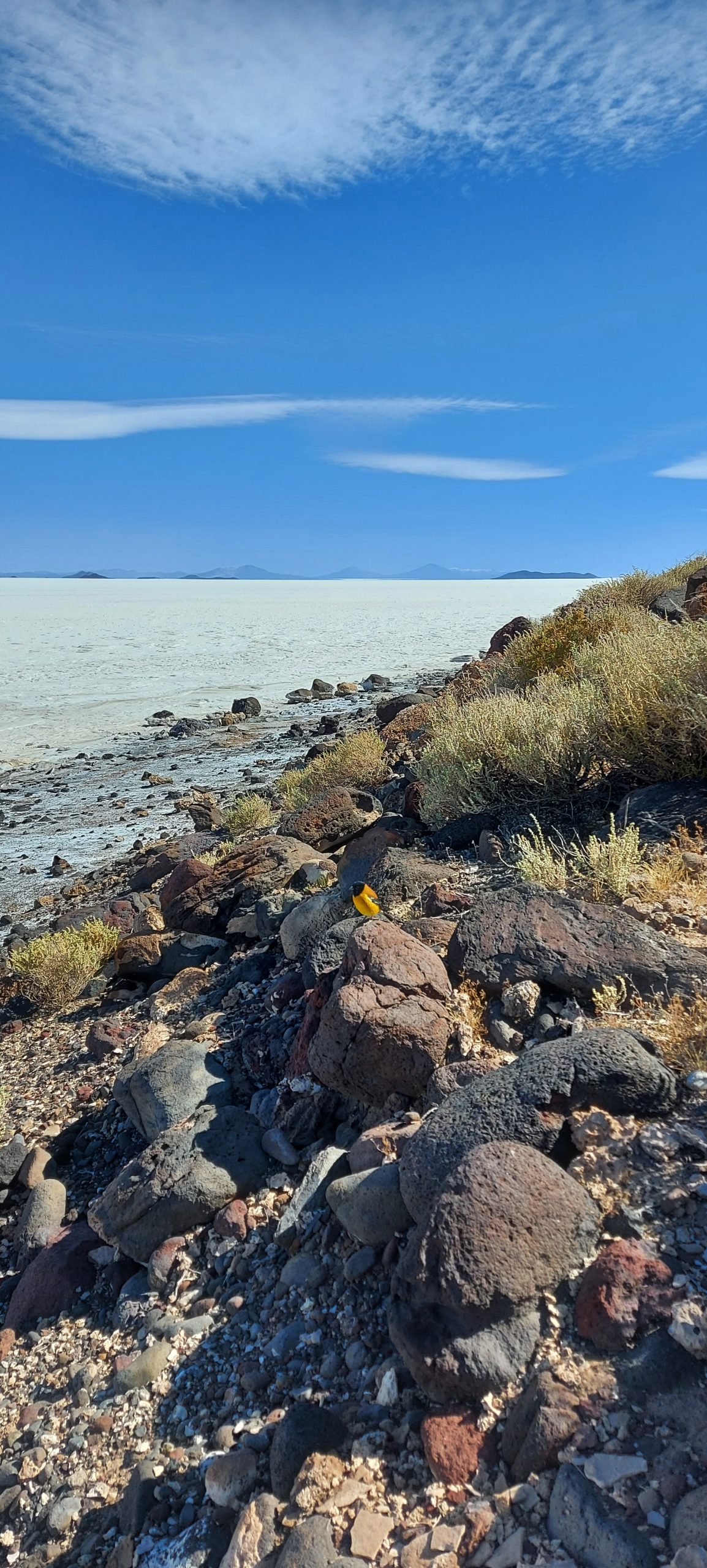
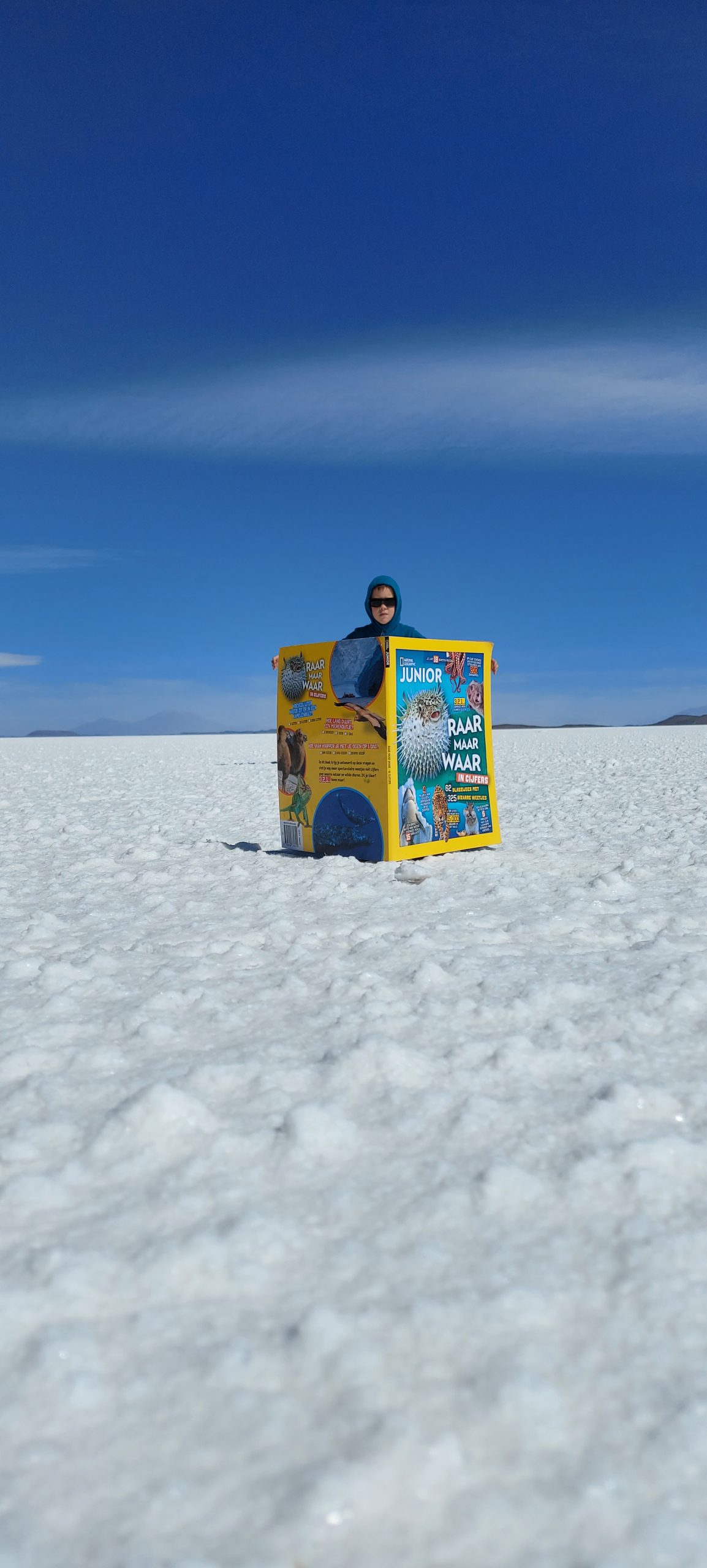

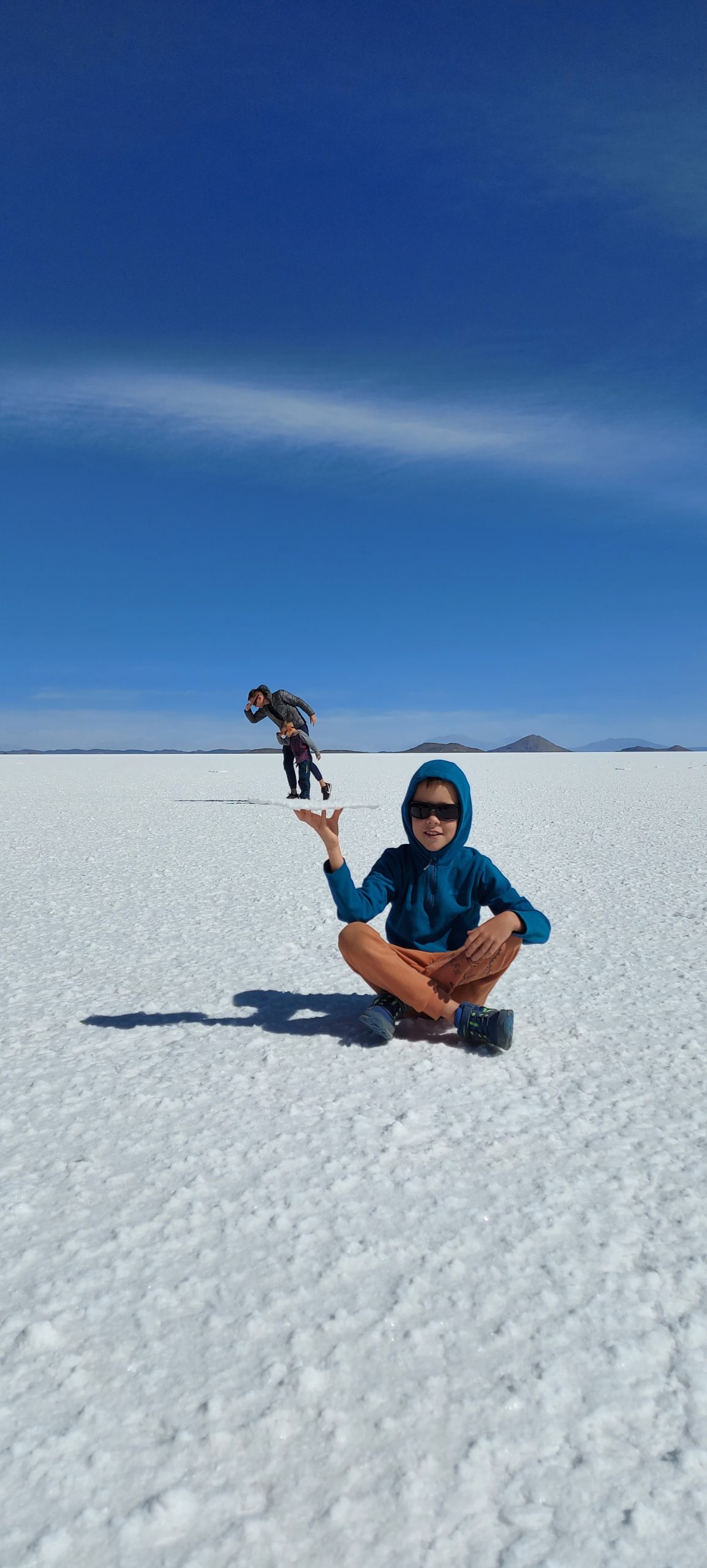
Ruta de las lagunas
From the beautiful salar we move on to the other highlight in the southwest of Bolivia; the ‘Ruta de las lagunas’ aka the route of the lakes. It is on everybody’s itinerary when you book a tour from Uyuni, and is a road through the desolate parts of Bolivia towards the Chilean border passing a string of beautiful lakes. But before we are at the start of this route, we have to cross another salar-type landscape and a hill, which again proves to be a challenge. See the stretch of sand/salt we take as a shortcut is fantastic, it is smooth and straight so we sail through it avoiding the heavily wash boarded main road. The next part however is a shortcut we should NOT have taken, as it is a mountainous track that gets bumpier as we go along until we get stuck in a dry stream bed.
This is part 2 of our boys freaking out that we will get stuck and never make it out of there, and to be fair – this truly is a part of road nobody takes, so waiting for help is not an option. The closest ‘main’ road is 12km away, so we really need to handle this ourselves and thus we calm down the boys and start building a bridge of big rocks to get out of this hole! True teamwork and 45 minutes passing gets us finally across, which means we are a bit closer to getting out of here and more positive that we will make it to our destination today. The rest of the road is equally bad, but we get to the main road, where we ask at a local tienda about the road ahead just to be sure we can make it. We are assured that the road is fine and being maintained, so we push on and start the Ruta de las Lagunas for real.


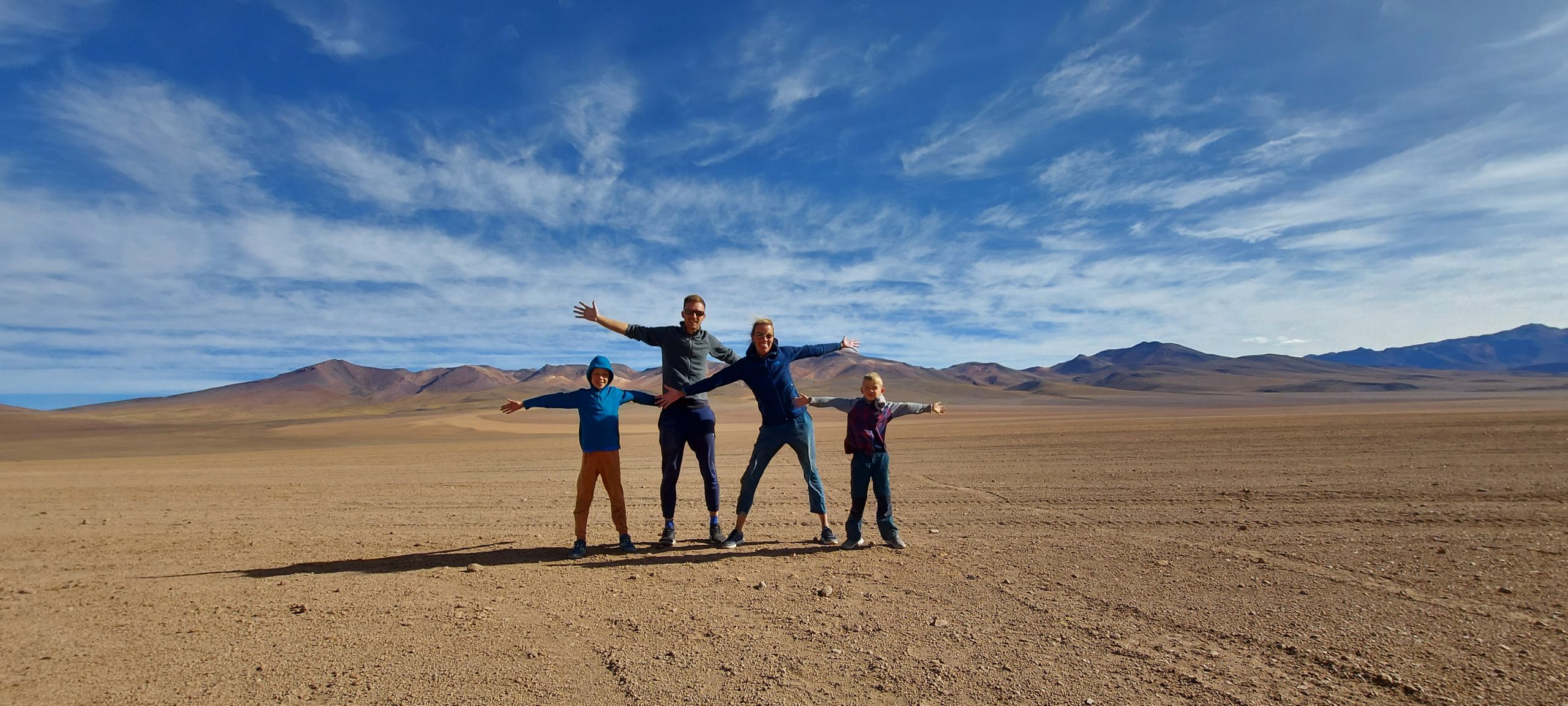
Long story short: It is still a horrible road/stretch/washboard/riverbedding/track/trail however you would like to call it, but we have to be honest – the surroundings make up for all the tough driving!! We make it to our destination of the Lago Colorado, after driving past beautiful lakes, stunning desertscapes, climbable rock formations and endless stretches of gravel tracks. Sometimes swearing under our breaths but mostly admiring the views we drive through as it is truly out of this world. As we get higher (5000m+), the air gets thinner and the winds get icy cold, but we push on and find a small hostal at the end of the day who is even willing to make us dinner. All inclusive stay for 7 euros per person… Hard to beat!
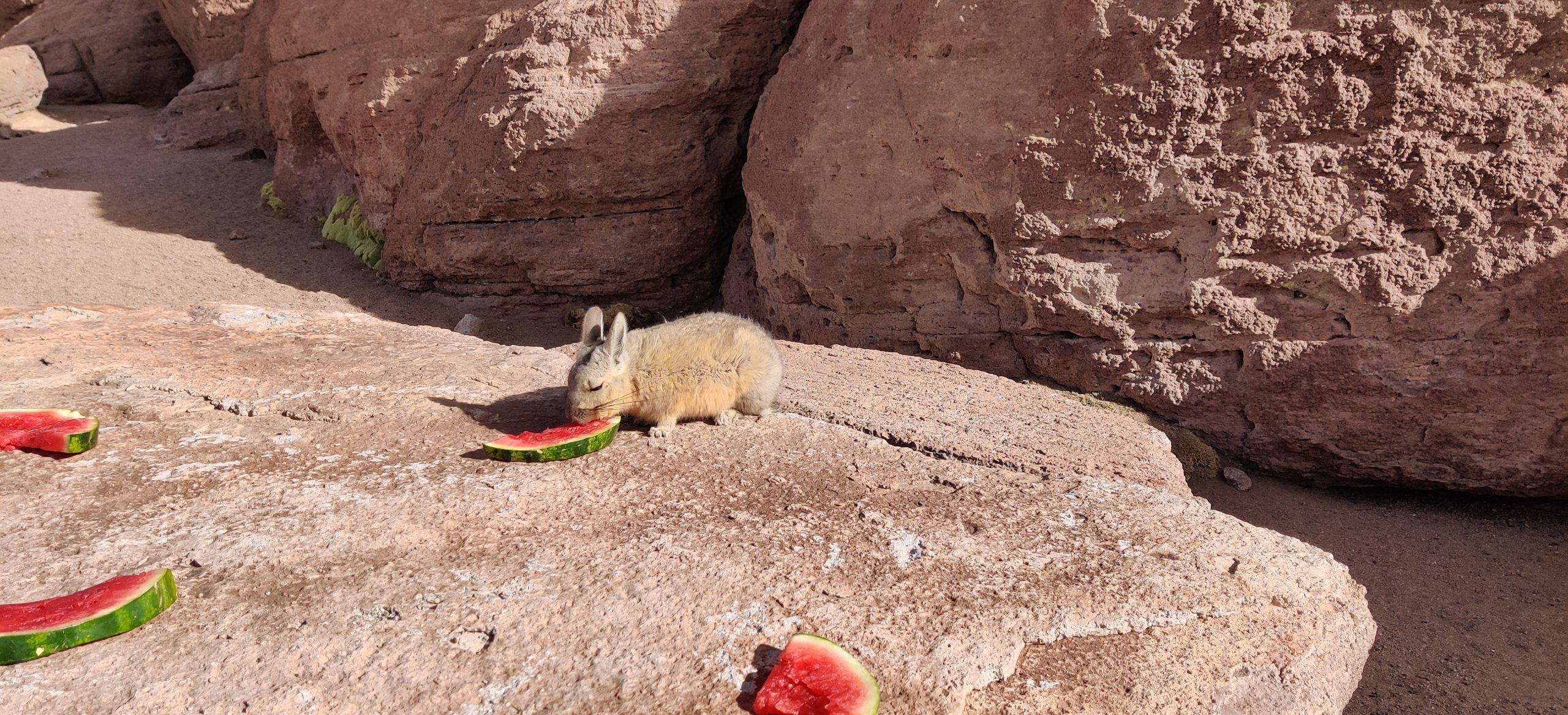

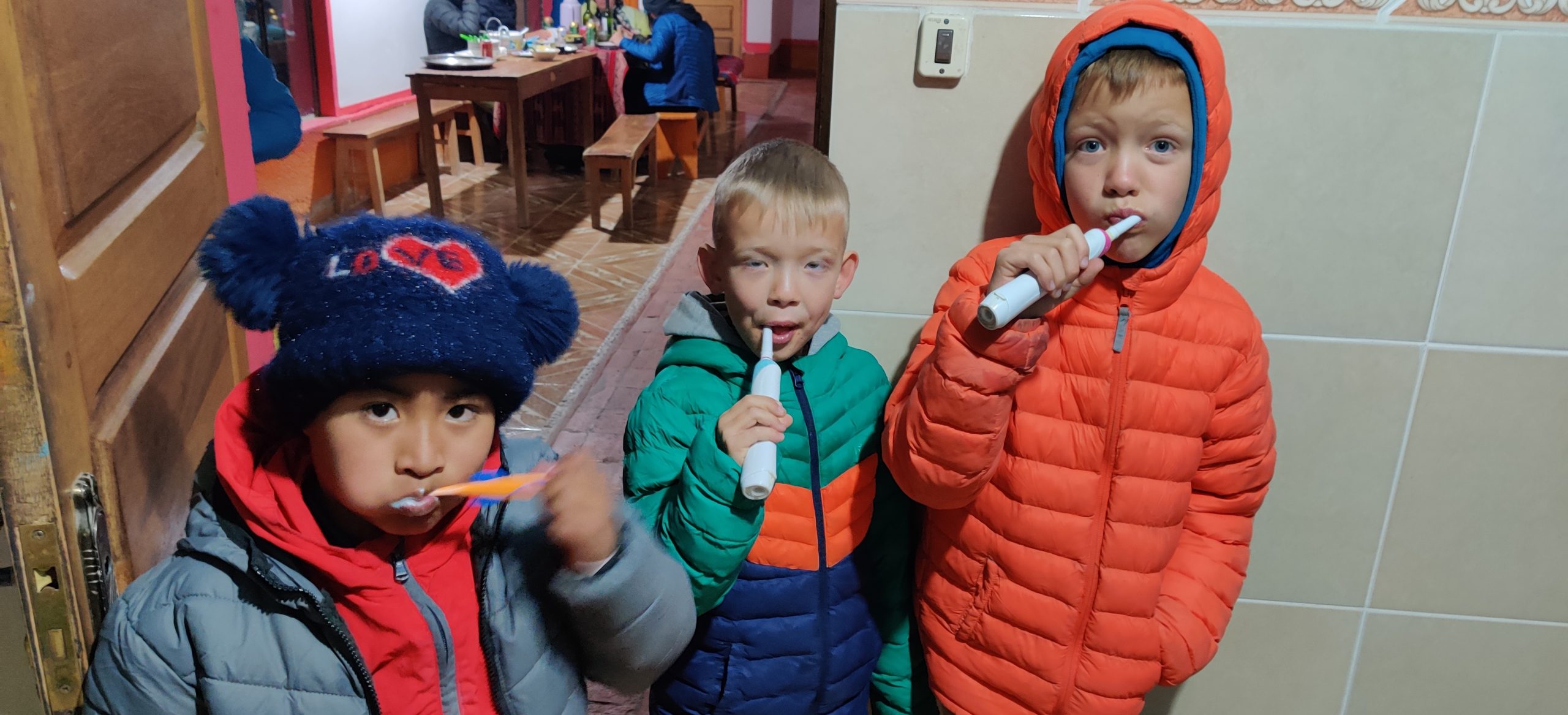
The next morning we chip the icicles of our noses and hit the road again after a pancake breakfast. Today has the thermal parts of the route on the agenda, starting with the geysers of Sol de Manana, and then on to the Termas de Polques for a warm bath. These Termas are supposedly on the main road towards the Chilean border, but the road stays very rough and bumpy, so we understand why this part of the country does not get a lot of traffic. On to the desert of Dali, with its beautiful colors and then on to the last two highlights on the road; Laguna Verde and Blanca. From here, you drive to the border post which is literally in the middle of nowhere and on a very windy cold patch of land – talk about harsh working conditions! The immigration officer apparently feels the same and tries to get us to pay money for the exit stamp, which we refuse… so he stamps them anyway and lets us pass into Chile.
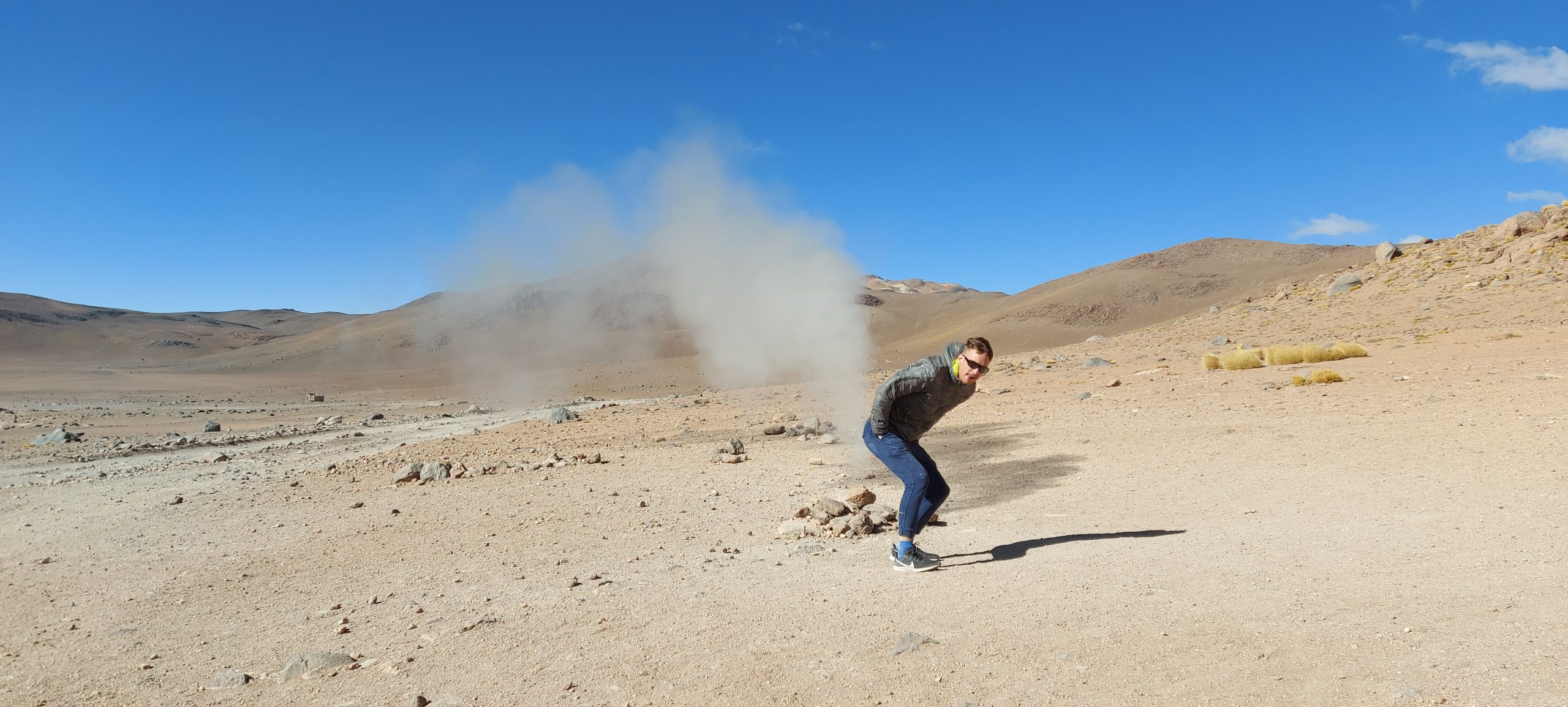
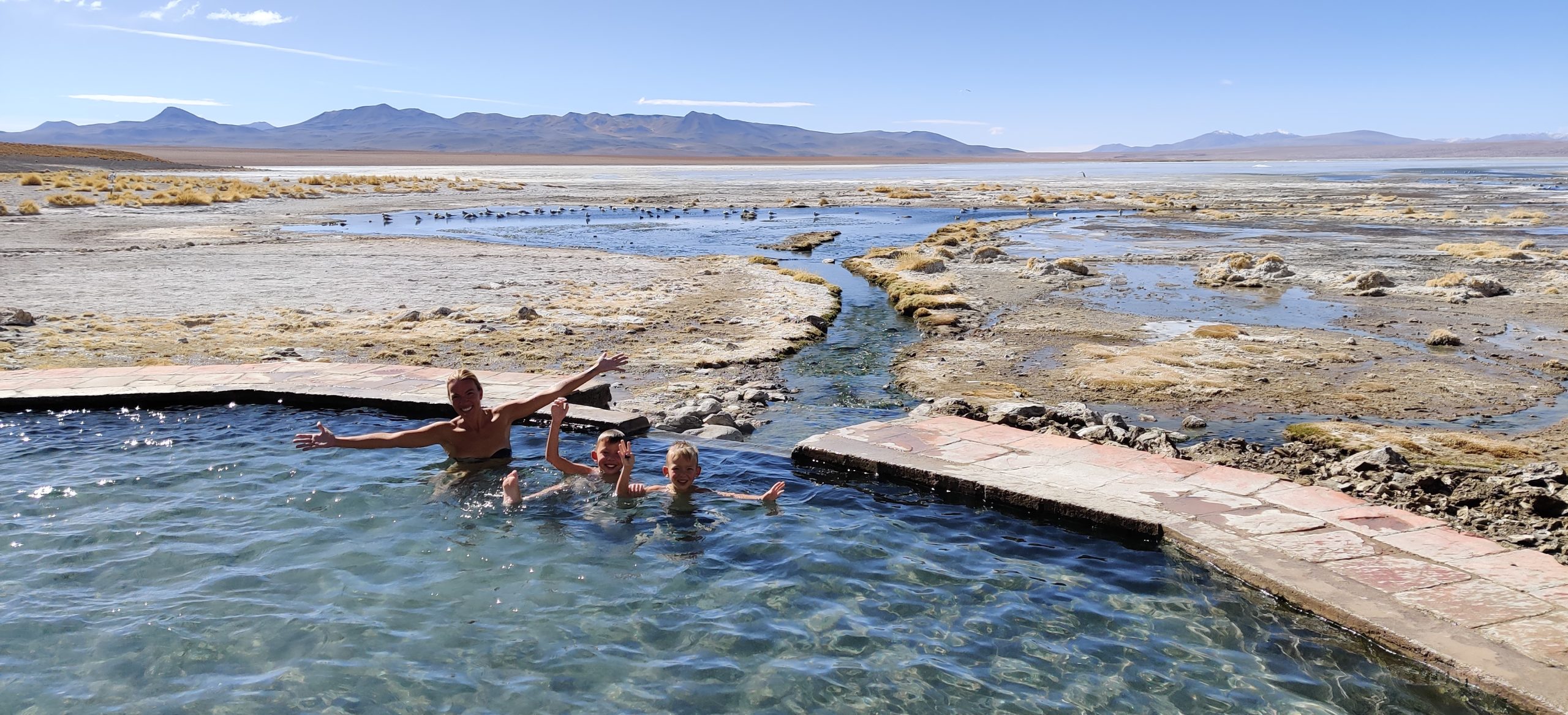
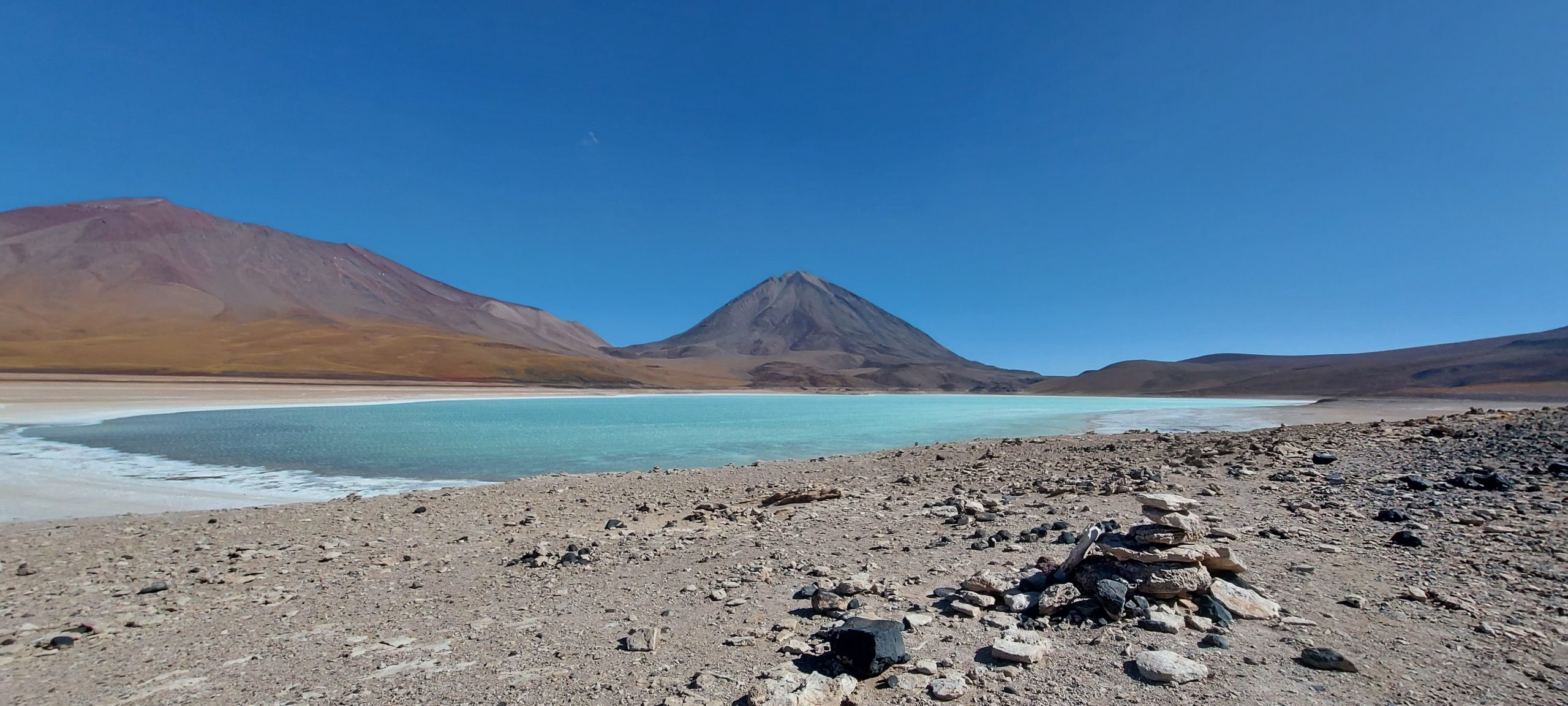
Chile otra vez! – Valle de la Luna
The Chilean side is better organised; their border employees are inside a big building and everybody coming out of Bolivia drive into their building through a big electric garage door! We go through very thorough checks of our paperwork and almost all our food is confiscated, but the reward is there: TARMAC!!!! How lovely to glide down a 40km road downhill (2200m descent) on smooth pavement after several days of gravel and potholes :-). We head out to San Pedro de Atacama for a short stay in the Atacama desert, and as we change our Bolivianos to Chilean pesos and get comfortable in our cabana, we take a sigh of relief but also rehash all of the adventure of the past days!

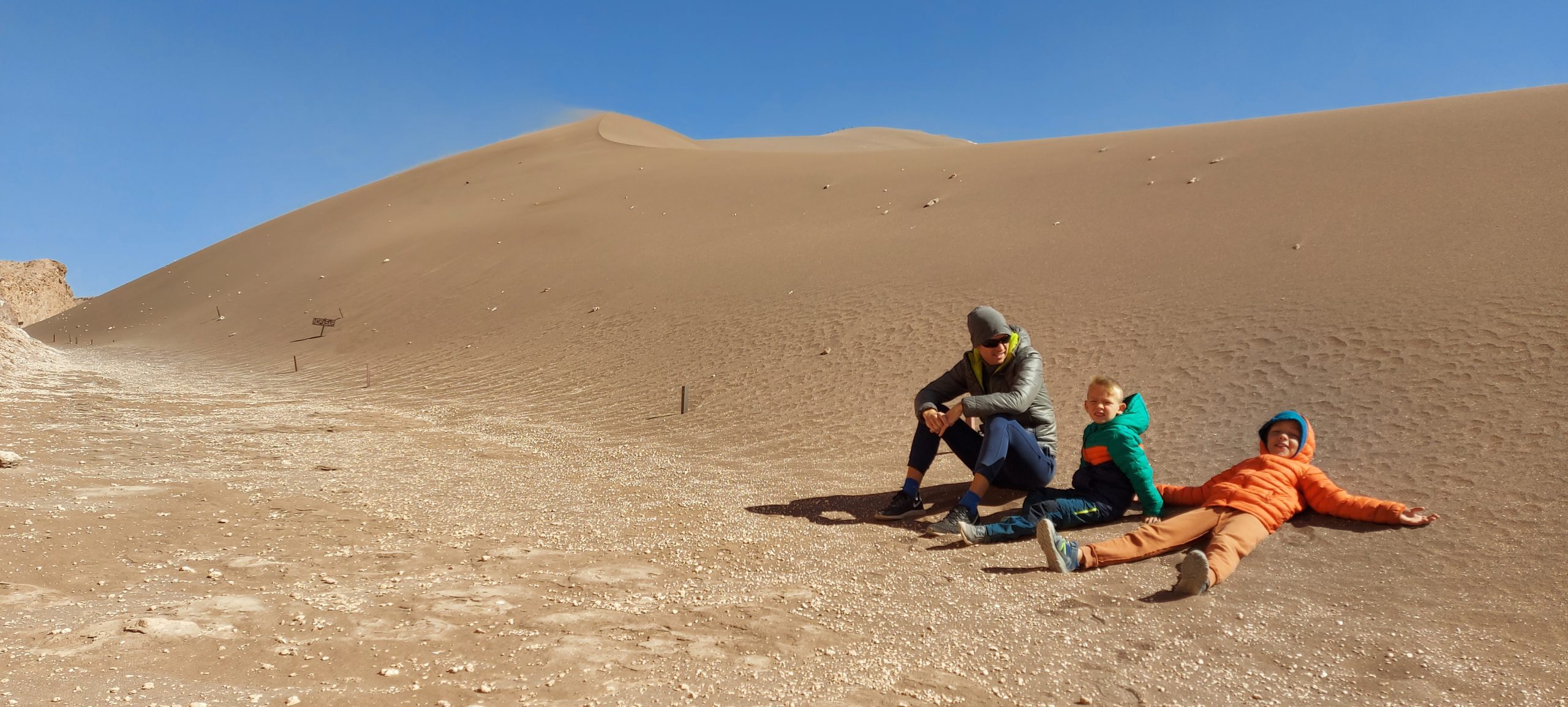
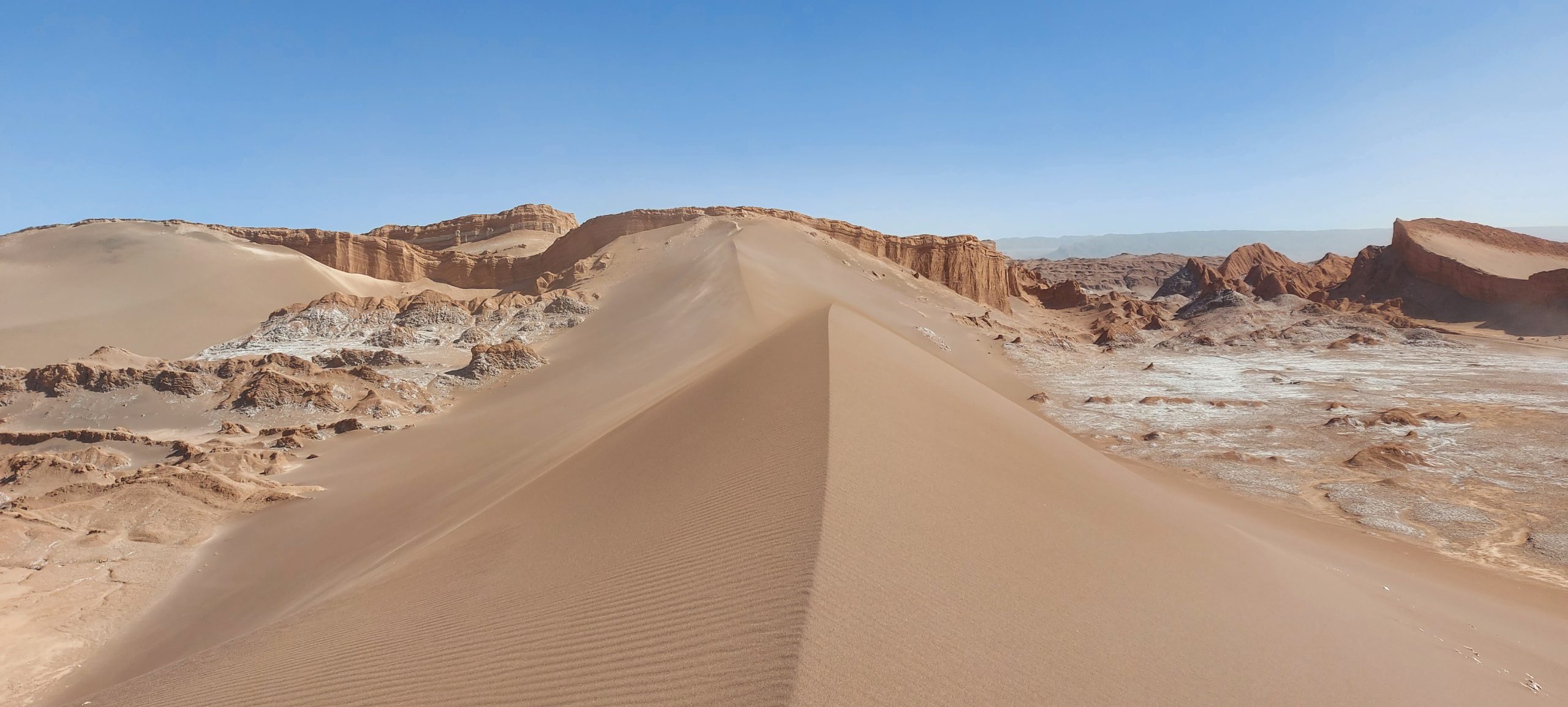
Our main sight is the Valle de la Luna, which is a national park site to explore and take some hikes in. Once we are there and paid for our entry tickets online, we are told however that half of the trails are closed due to the risk of rockfall, and as it is the windy season they may close the park altogether later that day! Hmmm… We drive in anyway and manage to take the few loops/hikes the park has to offer, and at the end of the road we get pulled in by a van of the park telling us to drive back as the park is closing. When asked how often it is this windy we are told ’10 days a year’… lucky us :-(. Thankfully we are allowed to come back the next day with our ticket to go to the viewpoint that is included, so we still get the most out of the valley of the moon. After this, it is back up the mountain again for another border crossing; the one into Argentina!
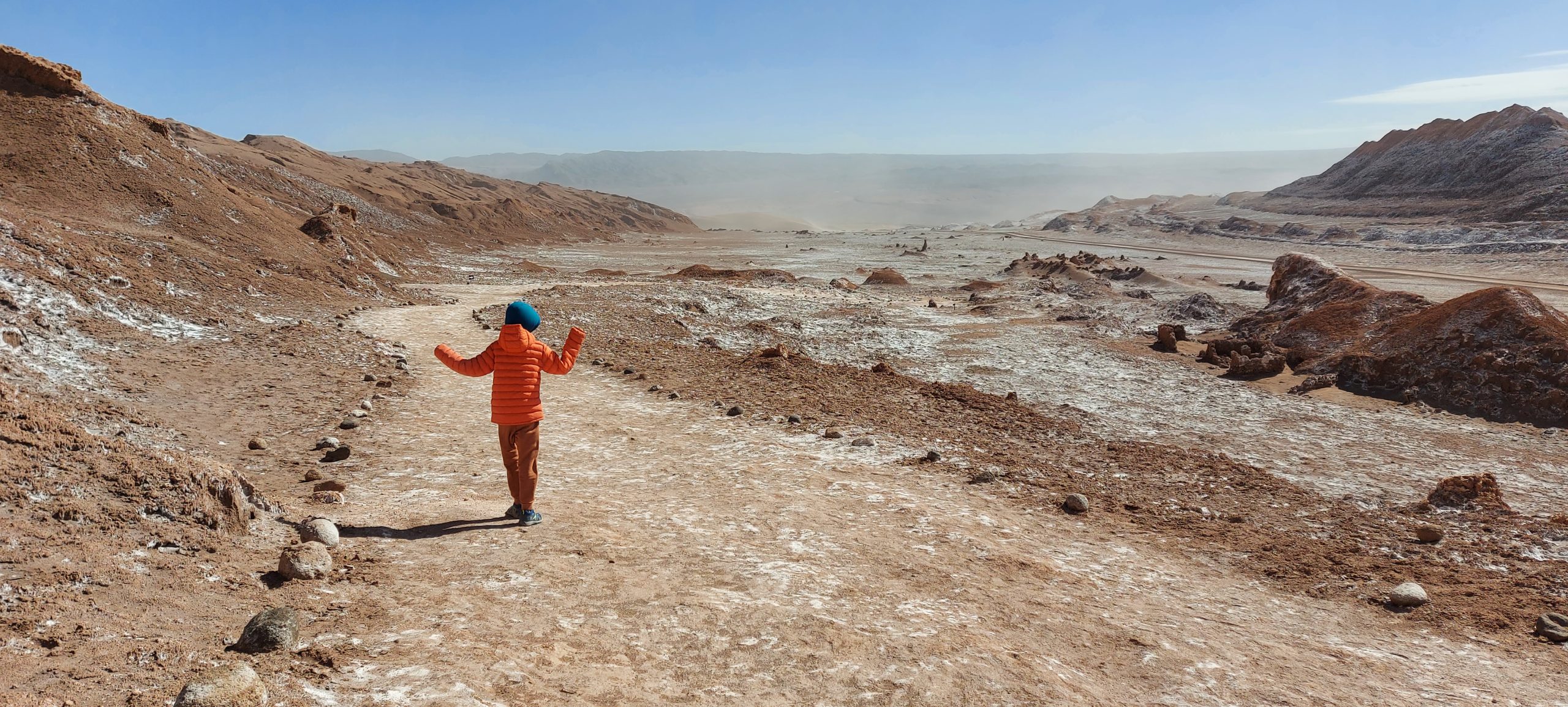
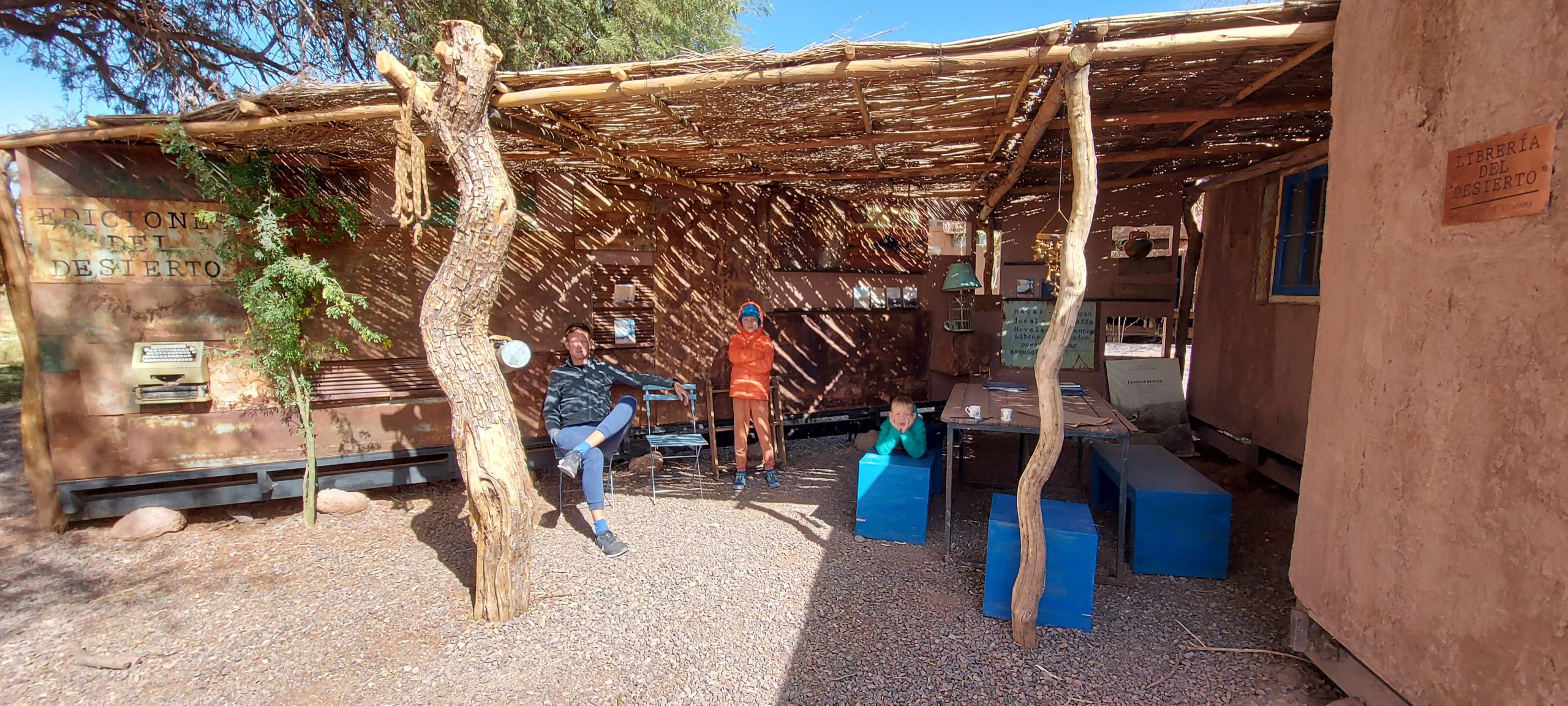
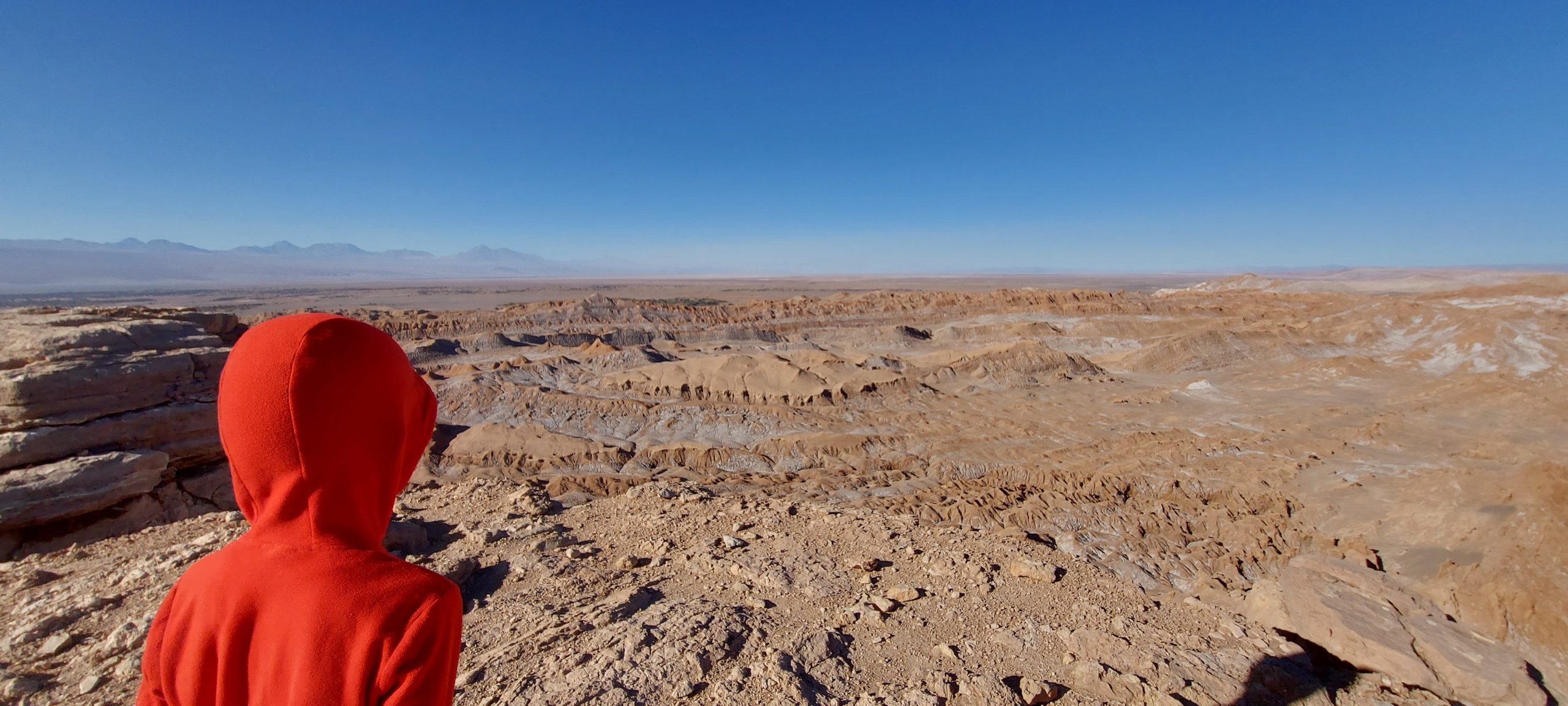
Next week: North Argentina

